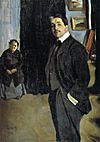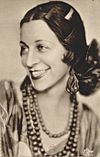Juana la Macarrona facts for kids
Juana la Macarrona (born May 3, 1870 – died April 17, 1947) was a famous Spanish flamenco dancer. She was known as a bailaora, which is the Spanish word for a female flamenco dancer.
Born Juana Vargas de las Heras in Jerez de la Frontera in Andalusia, she later added "La Macarrona" as her stage name. Her Gitano (Gypsy) parents helped her start her dancing career. She danced for many years, well into the 20th century.
Juana la Macarrona: Flamenco Star
Early Life and Dance Career
Juana came from a flamenco family. Her mother, Ramona de las Heras Valencia, was a flamenco singer. Her father, Juan de Vargas Barrío, was a flamenco guitarist. Juana started dancing in the streets with them when she was just seven years old. Her family had many dancers, including her ancestor Josefa Vargas.
Juana got her first regular job dancing at a café cantante in Sevilla. These were special cafes where flamenco shows took place. She also danced with a singer named El Mezcle in Málaga.
When Juana was about 16, a famous flamenco singer, Silverio Franconetti, saw her dance. He invited her to perform at his Café Silverio in Sevilla. Soon, La Macarrona became very well-known across Spain. She danced with the best flamenco artists in many famous café cantantes.
By the early 1890s, Juana was performing in big cities like Paris and other parts of Europe. She danced for kings, princes, and important people. La Macarrona even performed at the World's Fair in Paris in 1889. Before she was 30, she had already become rich and famous.

Her Unique Flamenco Style
La Macarrona's dancing style was considered traditional for her time. She focused on her upper body, moving her arms and hands beautifully. She used her brazos y manos (arms and hands) with great strength and grace. She also moved her long, ruffled flamenco dress, called a bata de cola, perfectly.
People said her footwork, called zapateado, was sharp and dramatic. One writer described how she captivated her audience: "The people are silent, holding their breaths... while the feet of La Macarrona give rhythm to her dance. ...La Macarrona dances to the compás [rhythm] of her own magnificent footwork."
Juana Vargas la Macarrona was very flexible. She could wrap her bata de cola around her feet after spinning, showing amazing skill. She especially loved dancing the soleares and alegrías, which are types of flamenco dances. People who saw her dance said she was "a fireball" and full of "gypsy temperament." They also said her duende (a special, magical artistic spirit) was amazing.
A Dancer's Personality
Juana was also known for her funny, quick remarks. Once, after performing in Paris many times, she knew some French. On a later train trip to Paris, she was asked to help with arrangements. But when they arrived, no one seemed to understand her. She joked, "It's not that my French isn't good, it's just that they've changed the damned language since I was here last."
Queen of Flamenco Dance
For decades, Juana was the top star among flamenco dancers in the café cantantes. People said she was "the one who has reigned for many years in the art of flamenco dance." She was especially dominant at the Cafe Novedades in Sevilla for fifteen years.
When La Macarrona decided to dance, she would rise like a queen, proud of her art. As she lifted her arms, it was as if she was blessing the world with her dance. Her powerful moves created "lightning and thunder" on stage.
Meeting Ballet Stars

Her fame reached the world of ballet and classical music too. Around 1917, four famous people came to see her dance in Sevilla: Serge Diaghilev (a ballet leader), Manuel de Falla (a composer), Léonide Massine (a choreographer), and Felix Fernandez García (a dancer). They said: "In Seville we went to see Ramirez and Macarrona... Their dancing more than lived up to our expectations, and we were dazzled by the ferocious power and elegance of their performance."
What's in a Stage Name?
"La Macarrona" was Juana Vargas's stage name. It is believed to come from two of her flamenco ancestors from the 18th century, Tío Juan Macarrón and Tío Vicente Macarrón. Her family had a long history of performing flamenco.
The word "macaroni" can mean a type of pasta or a sweet cookie. But in the 18th century, it also described a fancy English person who copied foreign styles. This meaning comes from an Italian word. So, "La Macarrona" might have also suggested that Juana was an "exotic talker" or a "dandy" of flamenco, fitting her unique dance and humor.
Later Years and Legacy
In 1910, when she was fifty, Juana la Macarrona made Sevilla her permanent home. She continued to be active in the flamenco world. In 1931, she even danced in a movie called Violetas Imperiales. She also performed in stage shows like El Amor Brujo in 1933 and Las Calles de Cádiz in 1933 and 1940.
She kept dancing well into her sixties. Even then, she was a main performer in big cabarets in Sevilla and Madrid. Sadly, she lost much of her money when her house was robbed. So, she sometimes had to perform out of need. Her fame from the cafés-cantantes faded, and she mostly danced in smaller flamenco taverns.
When she was 75, she gave an interview. She was sad about flamenco losing its popularity. She said, "Modern children, the youth, look at us as strange things, without thinking that we have made three generations cry with our gypsy ways."
La Macarrona taught many younger dancers. She thought Teresita España was her best student. Florencia Pérez Padilla, who became "Rosario" of the famous duo "Rosario and Antonio," also learned from her.
Judging a Famous Contest
In 1922, Juana was a judge at the Concurso de Cante Jondo in Granada. This event was created by composer Manuel de Falla and poet Federico García Lorca. It was a contest for new flamenco artists, but it also brought together famous performers. La Macarrona judged alongside other flamenco legends like Antonio Chacón and Manuel Torre.
Juana's presence made the contest very exciting. She would shout "¡Lapoteosis!" (meaning "Thunderstrike!") with excitement. Later, she even danced herself, with guitarists like Ramón Montoya and singer Manolo Caracol. Another famous dancer, Antonia Mercé "La Argentina", was in the audience. After Juana danced, La Argentina knelt down and took off La Macarrona's dancing shoes, carrying them away as a sign of deep respect!
Dancing in "El Amor Brujo"
In 1933, Manuel de Falla's ballet El Amor Brujo (Love the Magician) was performed again in Cádiz. This version focused more on its flamenco roots. Three older flamenco dancers, including La Macarrona, played the roles of "brujas" (sorcerers) in the show. At the end, they also danced an alegrías. The show was a big success and helped create "Ballet Español."
Meeting Carmen Amaya
In 1936, La Macarrona had a special meeting with the rising flamenco star, Carmen Amaya (1913–1963). Carmen was already famous around the world. This meeting was very emotional for Carmen. La Macarrona and another older dancer, La Malena, were seen as the most famous dancers of the old flamenco style.
When Carmen Amaya began to dance a soleares, the audience was silent. Then, her dancing became incredibly powerful. La Macarrona and La Malena stood up, crying. It was like they saw themselves reborn in Carmen. La Macarrona suddenly shouted, "You are the Queen!" The audience cheered, and Carmen kept dancing, with tears in her eyes. She was seen as the new "Pharaoh" of dance.
Touring with "Las Calles de Cádiz"
In 1933 and again in 1940, La Macarrona toured with a popular stage show called "Las Calles de Cádiz" (The Streets of Cadiz). This show was created by La Argentinita, another famous dancer. It brought the lively street life of the Santa María neighborhood in Cádiz to the stage. Flamenco artists played different city characters and performed songs and dances. This show was considered a highlight of theatrical flamenco.
Remembering a Legend
La Macarrona passed away in Sevilla in 1947. At that time, flamenco was not as popular, and she was "poor and forgotten." She even thought flamenco was dying.
However, about ten years later, flamenco became very popular again. Juana Vargas, La Macarrona, was well remembered. In 1935, a flamenco singer named Ferdinando el de Triana wrote, "Everything that can be said about La Macarrona is not enough." Many people still consider her one of the greatest female flamenco dancers of all time.
See also
 In Spanish: Juana la Macarrona para niños
In Spanish: Juana la Macarrona para niños
- Flamenco dance
- Carmen Amaya
- Silverio Franconetti
- Café Cantante
- Concurso de Cante Jondo
- La Argentina
- La Argentinita
- Women in dance



